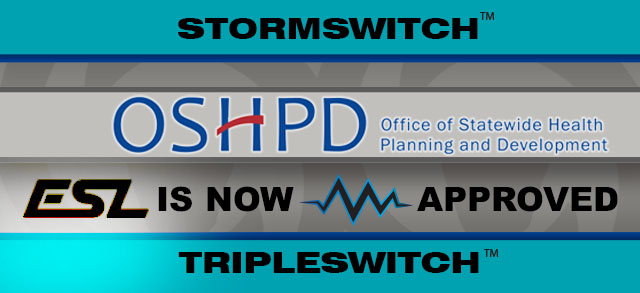
FOR IMMEDIATE RELEASE
ESL Announces OSHPD “OSP” Special Seismic Certification of StormSwitch™ and TripleSwitch™ Emergency Power Products
Date: March 25, 2019
Corona, CA — ESL Power Systems, Inc. now features Emergency Power connection equipment that is Special Seismic Certified from the California Office of Statewide Health Planning and Development (OSHPD). This approval is intended to assist specifiers in meeting NEC and local code requirements for seismic certification of emergency and standby power equipment in critical facilities.
“We determined that obtaining approval by OSHPD would provide enormous value in knowing our core products have been shaker-table tested and certified to endure major earthquakes without fail” states ESL’s President Michael Hellmers. In addition to offering pre-approved seismic emergency back-up products to help end users meet the strict OSHPD-requirements for projects based on the current California Building Code (2015), ESL’s Emergency power product line includes UL/cUL 1008 Listing up to 3000 amps for manual transfer switches and 3-way manual transfer switches.
Where hospitals and critical care facilities need back-up power they must choose equipment that is OSHPD certified; critical equipment not pre-approved will require 3rd party testing and projects will be delayed which translates into added costs. The OSHPD Special Seismic Certification (OSP) was created to help streamline and simplify hospital construction.
In addition, ESL’s StormSwitch™ and TripleSwitch™ are designed and tested in compliance with IBC 2015. For specific information on ESL’s OSHPD seismic certified emergency power equipment and to download Specifications for Engineers, visit eslpwr.com/oshpd.
Established in 1995, ESL specializes in engineered power distribution solutions that are safe to use and easy to operate. ESL’s line of emergency power connection equipment for commercial and industrial applications are UL/cUL 1008 Listed for StormSwitch™ – Manual Transfer Switches up to 3000A, TripleSwitch™ – 3-Way Manual Transfer Switches up to 3000A and TempTap™ – Generator Docking Stations up to 3200A.
As a certified small business, ESL is proud to provide Made in the USA solutions with the lowest cost of ownership in the industry. ESL demonstrates its continuous commitment to customers by delivering sound workmanship on time and within budget. For more information, visit eslpwr.com/oshpd.
###



